Welcome to To Vegetables, With Love, a celebration of a vegetable life, less ordinary. ‘ Find archived recipes on my recipe index.
My book Tenderheart is available from Books are Magic, Kitchen, Arts and Letters, Book Larder, Bold Fork Books and also here or here.
This week’s recipe is for free for all.
My mum cooked steamboat (what is more commonly known as hot pot), once a year, in the dead of winter, when her cavernous house became unbearable with the big chill. Sydney winters are mild by most standards but since most homes have no heating, it can feel arctic inside.
I waited all year for steamboat night. I loved the wild raucous of the ritual, the clatter of bowls, the splatter of broth. The hot pot overloaded with ingredients, impatient diners prodding to hasten the cooking. Steamy windows from the simmering broth. My mother’s handiwork can be seen on the table - shards of beef and pork as thin as gossamer, and glistening hand pounded fish cake paste. Choy sum, bok choy and gai larn piled high. There’s fresh noodles too, button mushrooms, lettuce, watercress. There is always a bowl of raw wonton filling, ready to be wrapped table side and tossed straight into the bubbling cauldron.
While it was a once-a-year specialty in my mum’s house, I have made it an everyday meal in ours. It is dinner that I don’t have to cook. The work is merely in assembling ingredients and arranging them artfully on a plate. Once it’s time to eat, the onus is on others to do the work. It is a great Sunday night option, when an easy yet cozy option is required
Steamboat, hot pot, or its Japanese counterpart shabu shabu, is often associated with meat. At home, this need not be the case at all. In fact, t is the perfect opportunity to present a vegetable rich table. This guide is a demystification of hot pot, showing you how easy it is to create your own warm, comforting and interactive vegetarian/vegan meal at home with family and friends.
THE ESSENTIALS
The vessel + burner
Burner: Growing up, my mother always used a portable burner with a pot on top, so this is my preferred option. This is my favourite portable burner by a Japanese brand called Iwatani (I also use this to make cooking videos as it’s small, light and can be moved easily around the house), but you can also opt for a small, single burner induction cooktop.
Vessel: I use this dual-sided pot because it means you can either have two types of broth, or if you live with meat eaters like me, you can have one side for vegetarians and the other side for carnivores. It also works on induction cooktops.
There are also pricier all-in-one systems that feature a pot with a burner. I’ve never used these but could be a good option for easy storage but they are a much more expensive option.
Ladles / spoons
You’ll need some deep-ish, slotted spoons and ladles to fish the ingredients out of the broth. You can purchase these wire skimmers Chinese supermarkets or online; something these metal skimmers would work too.
INGREDIENTS
This is where we can go as rogue as we want.
Vegetables
Opt for quick cooking vegetables such as:
Any Asian greens such as choy sum, Gai Larn, baby bok choy, amaranth, pea shoots, tatsoi
Napa cabbage (wombok), broccoli, cauliflower
snow peas, sugar snap peas, asparagus,
baby corn
All the mushrooms
Iceberg lettuce, watercress
Daikon radish
Tofu
Medium or firm tofu, cut into triangles or chunks
Tofu puffs
Fried tofu rolls
Tofu knots
Carbs
Noodles: fresh or dried both work. I love thick udon and mung beans vermicelli
Rice cakes
Dumplings or wontons (store bought is perfect)
Filled pasta such as ravioli or tortellini (not traditional but kids love it)
Broth
Think of the broth as a starting point for more flavor. It doesn’t need to be particularly salty as it is seasoned by the ingredients that cook in it. Focus upon aromatics and spices.
Go light with a quick dashi made by slowly simmering seaweed or dried shiitake mushrooms in water for 10 minutes, or opt for something with more spice. See below for two broth options.
As you cook, the broth will reduce. Keep some hot/boiling water close and top the broth up as needed.
At the end of the meal, it is common for the broth to be sipped like a soup.
Sauces
We usually serve hot pot with ginger scallion oil and chilli crisp. My mushroom ‘xo’ sauce in my book FAMILY is nice too. Below, I’ve included my ginger scallion oil from To Asia, With Love below, along with my umami crisp from Tenderheart.
(sidenote: US readers, enter our fun Lunar New Year Fly By Jing giveaway below to snag some chili crisp/oil for your next hotpot)
LUNAR NEW YEAR is this week and to welcome the Year of The Snake, I am running a special giveaway with my good friends at Fly By Jing. Their chili oils are perfect condiments for hotpot! One of my absolute favourite chili crisps ever is their Chengdu Crunch. We will be giving away TWO Year of the Snake gift boxes. To enter, comment below and share your favourite way to enjoy chili crisp or how you will be celebrating Lunar New Year! Due to shipping and logistics, competition is open to US residents only (sorry to everyone else ;)
🐍
Here is my Lunar New Year themed recipes for this week!
Monday: Keep it easy and bright Lemon tofu
Tuesday: Noodles are essential this week. Cannot go wrong with this vegetarian chow mein
Wednesday: Are you looking to celebrate Lunar New Year’s Day like my family does? Make these Gok Jai dumplings, a treasured family recipe which I shared on NYT Cooking for their first ever DUMPLING WEEK. These crystal skin dumplings are a specialty from Zhongshan, where my parents are from. They are a project but the result is so worth it. These are not run-of-the-mill dumplings, these are completely unique and memorable. To help you along, there’s a YouTube Video with the recipe too.
Thursday: This is my lunar new year’s essential, lo han jai or buddha’s delight, from my newsletter archives
Friday: these broccoli wontons with umami crisp from TENDERHEART are easy and satisfying
🥦 My cookbook, Tenderheart is for cooking vegetables, all year round. Pick up your copy here. It is also mostly vegan (or vegan-izable) and gluten-free adaptable.
Vegetatarian Hot Pot
© By Hetty Lui McKinnon for To Vegetables, With Love.
For those who do not want to hot pot, please use these broths for a bowl of noodle soup! Just remember to season it appropriately as the base recipes below are either unseasoned or salted only lightly specifically for hotpot.
BROTHS
Ginger mushroom broth
Makes 5 - 6 cups
2 teaspoons sesame oil (roasted or unroasted)
1 inch / 2.5cm piece (about 20g) ginger, thinly sliced (peeled or unpeeled)
4 - 6 large Chinese dried shittake mushrooms, rehydrated in 1 cup hot water for 30 mins
Heat sesame oil in medium pot in medium heat. Add the ginger and stir until they are fragrant and slightly caramelised around edges, about 2 minutes.
Remove the mushrooms from soaking water and add them to the ginger. Strain out any sediments from the mushroom soaking liquid and add this to the pot (should be about 1 cup) and add another 4 - 5 cups of water of water - you want about 6 cups of stock. Season with salt - to bring out flavor but doesn’t have to be overly salty. Simmer on medium for 5 to 10 minutes, reducing heat so it doesn’t boil.
Transfer to hot pot pot.
As the broth reduces, top up with hot/boiling water.
Spice broth
Makes 5-6 cups
2 teaspoons sesame oil (roasted or unroasted)
2 garlic cloves, finely chopped
2 to 4 whole dried chillies, crushed (or 1/2-1 teaspoon crushed red chili flakes or 1 red chili, such as Fresno) (remove seeds for less heat)
1/2 to 1 teaspoon Sichuan peppercorns, crushed
1 inch / 2.5cm piece (about 20g) ginger, thinly sliced (peeled or unpeeled)
sea salt
2 teaspoons roasted sesame oil
2 tablespoons soy sauce or tamari
2 star anise (optional)
Place a medium pot over medium heat. Add the sesame oil, garlic, and ginger and stir until fragrant, 30 to 60 seconds. Add the chilies, sichuan peppercorns and stir until fragrant, about 30 seconds. Add the water and soy sauce and stir. Add the star anise, if using, and cook on medium heat for about 10 minutes, to allow the flavors to meld.
When ready to hot pot, transfer to the hotpot pot.
As the broth reduces, top up with hot/boiling water.
SAUCES
Umami Crisp
Makes about 2 cups
20 g (½ cup) dried porcini mushrooms, roughly chopped
1 shallot/eschalot, roughly diced
4 garlic cloves, finely chopped
½ cup flaked almonds
½ cup toasted white sesame seeds
1 cinnamon stick
1–2 tablespoons red chilli flakes
1 tablespoon gochugaru flakes
310 ml (1 ¼ cups) neutral oil
1 tablespoon soy sauce or tamari
2 tablespoons roasted sesame oil
2–3 teaspoons sea salt flakes (to your taste)
Place the mushroom, shallot, garlic, almonds, sesame seeds, cinnamon stick, red chilli flakes, gochugaru and neutral oil in a saucepan and heat over medium–high heat for 1–3 minutes, until the oil starts to bubble around the edge. Reduce the heat to medium–low and cook for 15–20 minutes, stirring occasionally, until the eschalot, garlic, almonds and sesame seeds are golden and crispy. (Be watchful – the time this takes will depend upon your stovetop heat and the size of your pan, so I recommend staying close by to monitor progress. I also recommend tasting along the way.)
Strain the oil through a fine-mesh sieve set over a bowl and leave the mixture to cool – this will allow it to crisp up further. Set the oil aside.
When the mushroom mixture is completely cool, stir it back into the oil (including the cinnamon stick as this will continue to flavour the oil once stored) and add the soy sauce or tamari, sesame oil and sea salt flakes (I recommend starting with 2 teaspoons of salt and increasing to 3 if you want it saltier).
Store the umami crisp in a sterilised jar in the fridge for up to 3 months.
Ginger–scallion oil
Makes about 1 cup
3 to 4 inch piece (60 - 80g) ginger, peeled and finely chopped
3 scallions, finely sliced, white and green parts separated
2 teaspoons tamari or gluten-free soy sauce
1 teaspoon sea salt
150ml (approx 2/3 cup) vegetable or other neutral oil
Place the ginger, white part of the scallion, tamari or soy sauce and sea salt in a heatproof bowl.
Place the oil in a small saucepan over medium–high heat for 3–4 minutes.
It is hot enough if it sizzles when you place a wooden chopstick into it. Very carefully pour the oil over the ginger and scallion mixture. Allow to cool, then add the green part of the scallion and stir to combine. Store in an airtight container in the fridge for several weeks. Bring to room temperature before using.
Io Vegetables, With Love is dedicated to vegetables and it is a joy to bring you a new recipe every week. Thank you to everyone who subscribes, especially to paid subscribers who make this work possible.



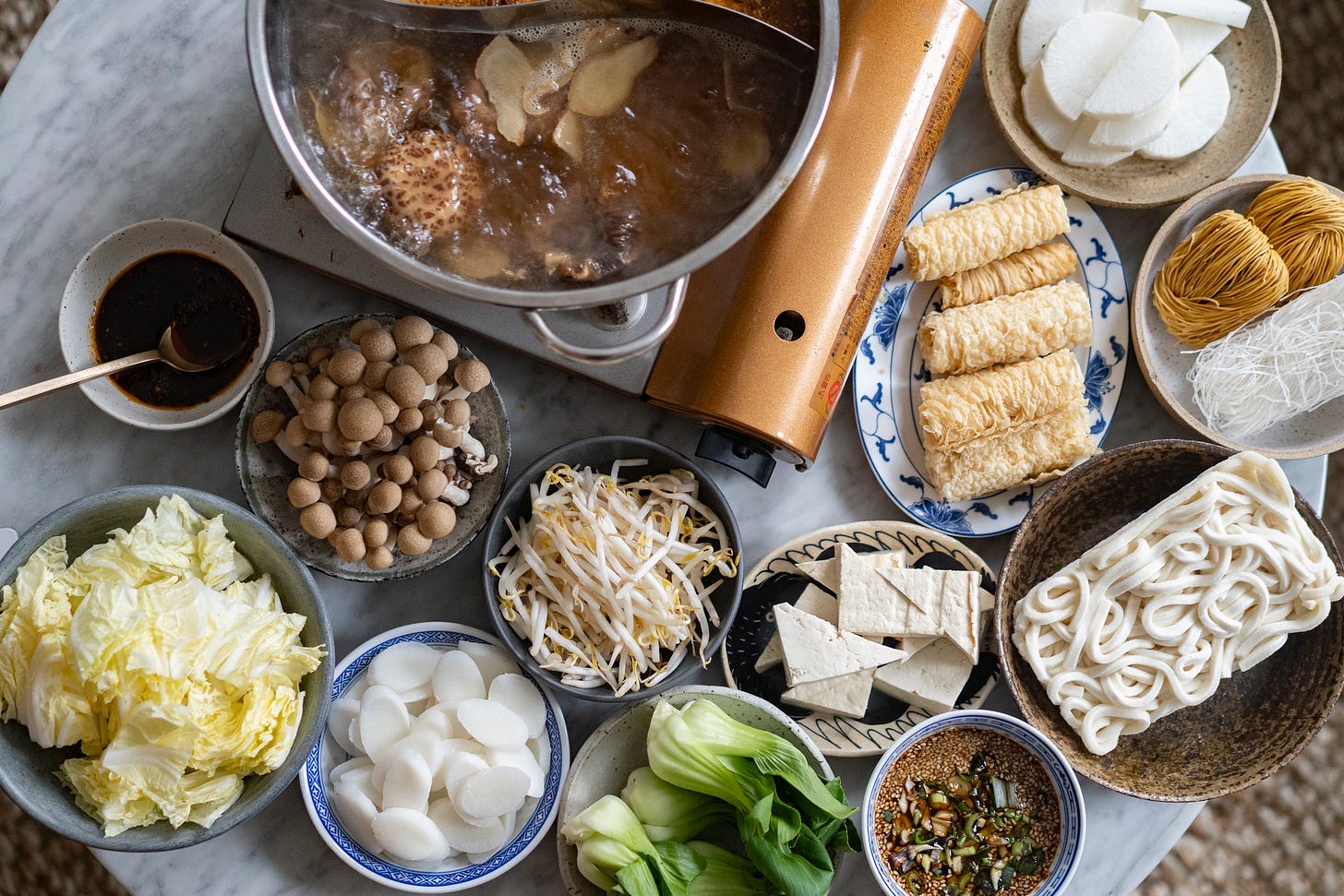


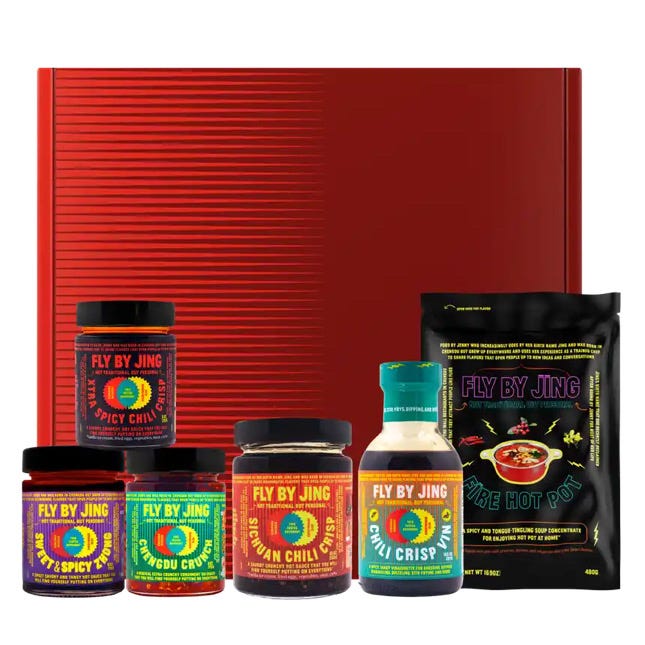

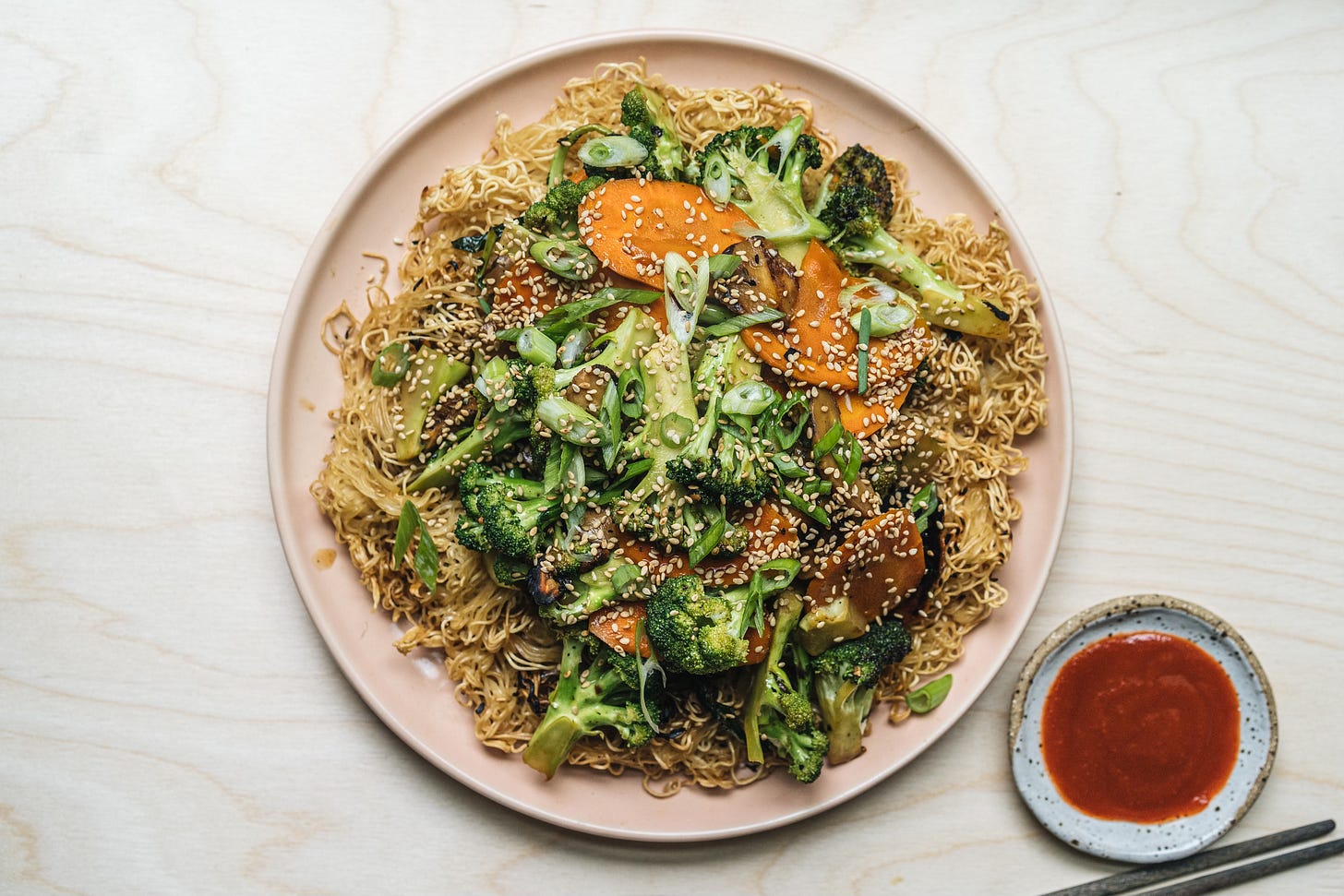
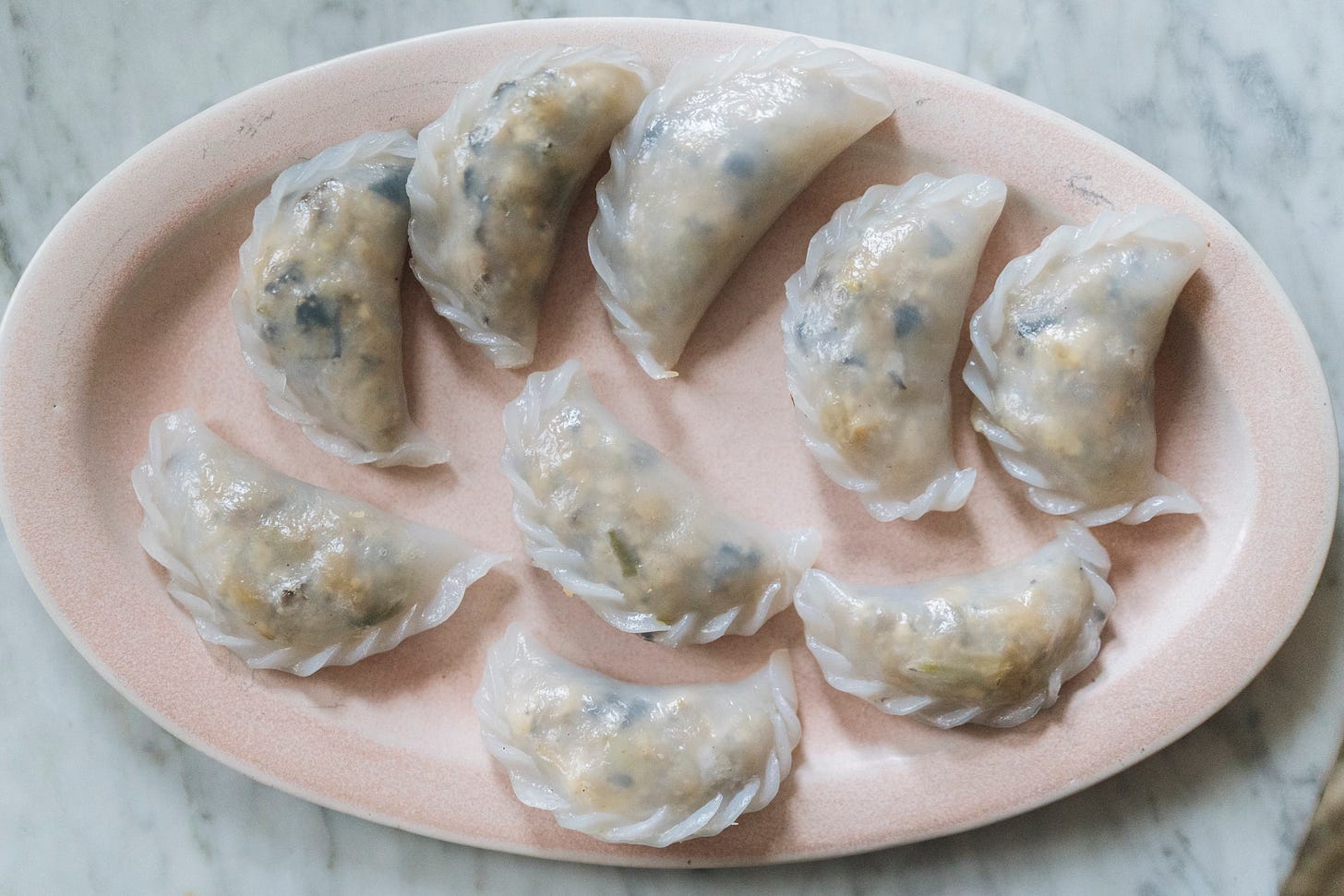

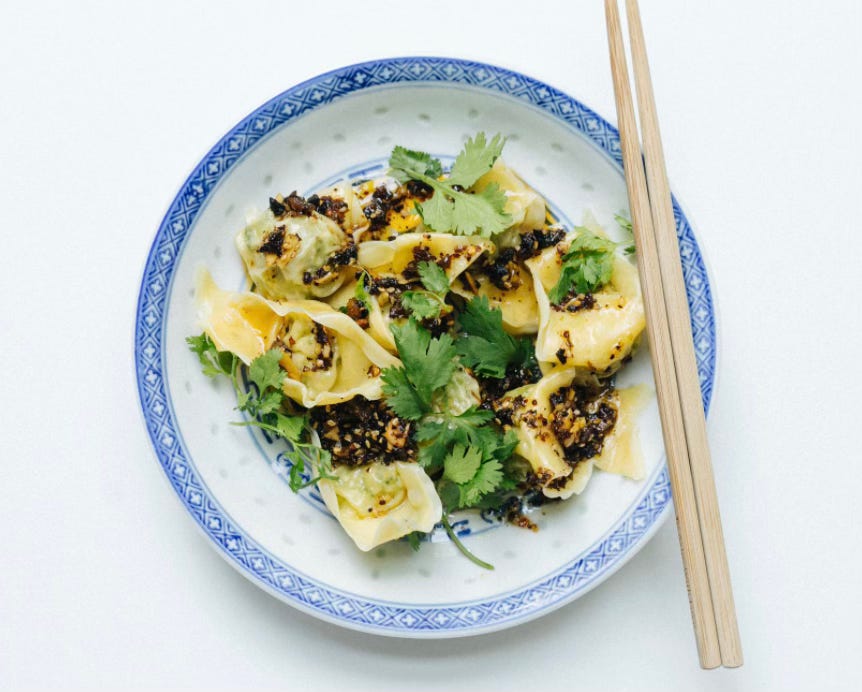


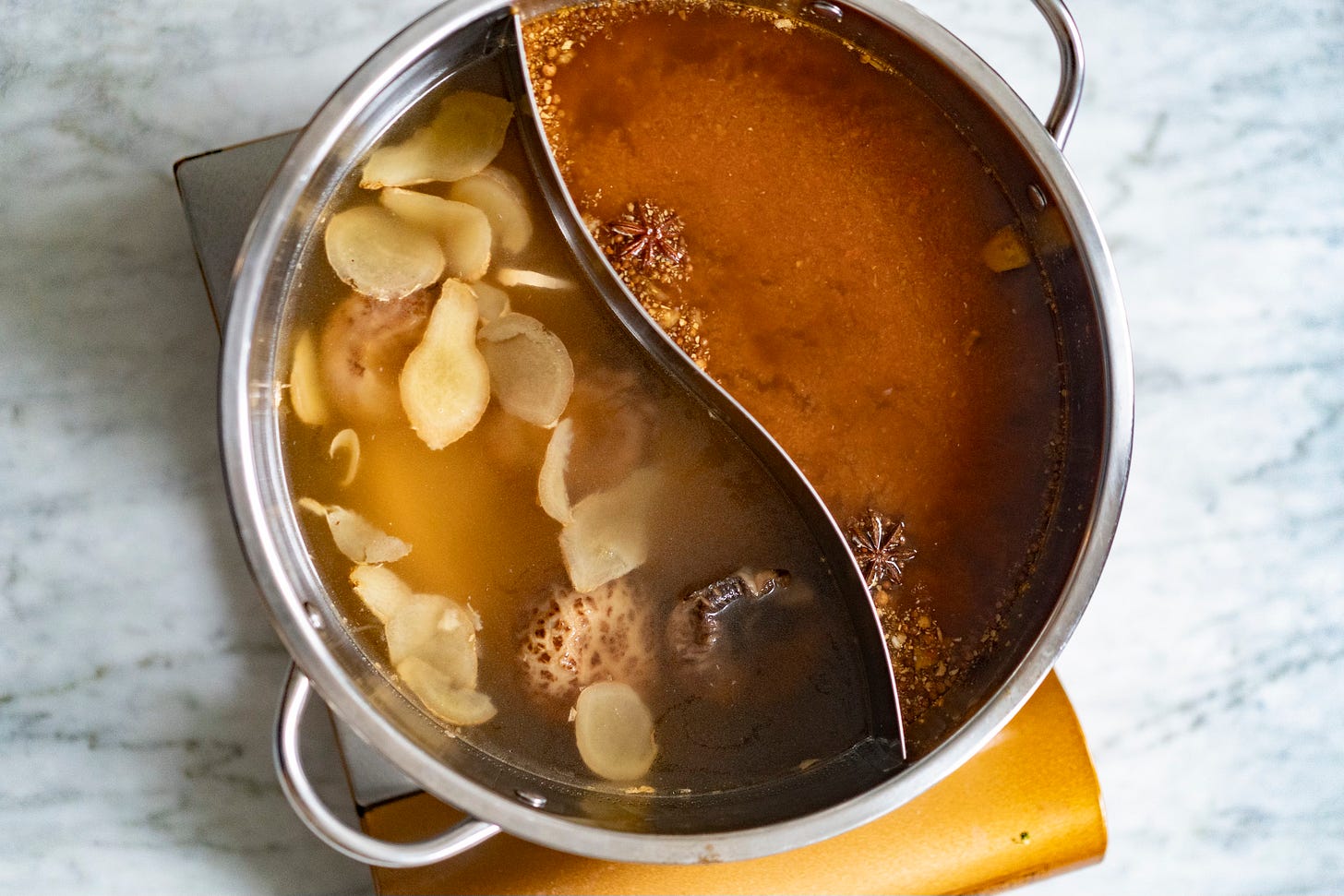

So pleased to have some guidance on preparing and serving a vegan hot pot meal and a basis for vegan ramen broths. Thank you!
Regarding chili crisp, I like it for adding a big hit of flavor to vegetable chow mein and also on top of green salad with cubed tofu.
Chili crisp fettuccine Alfredo